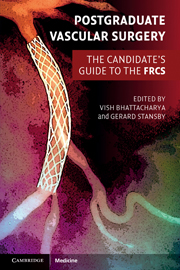Book contents
- Frontmatter
- Contents
- List of contributors
- Preface
- Section 1 Final FRCS vascular clinicals
- Section 2 Final FRCS vascular topics
- 1 Vascular risk factors and their management
- 2 Management of acute limb ischaemia
- 3 Chronic lower limb ischaemia, critical ischaemia and the diabetic foot
- 4 Endovascular and surgical options for peripheral revascularisation
- 5 Abdominal aortic aneurysms
- 6 Thoracic, thoracoabdominal and suprarenal aortic aneurysms
- 7 Aortic dissection
- 8 Popliteal artery aneurysms
- 9 Femoral artery aneurysms
- 10 Carotid, subclavian and vertebral disease
- 11 Diagnosis and management of thoracic outlet syndrome
- 12 Diagnosis and management of hyperhidrosis
- 13 Chronic mesenteric ischaemia
- 14 Acute ischaemic colitis
- 15 Vascular trauma
- 16 Indications and management of lower limb amputation
- 17 Leg swelling and lymphoedema
- 18 Varicose veins and chronic venous insufficiency
- 19 Management of deep vein thrombosis
- 20 Infection in vascular surgery
- 21 Vascular malformations
- 22 Vasospastic disorders and vasculitis
- 23 Critical care considerations and preoperative assessment for general and vascular surgery
- 24 Access surgery
- 25 Basic outline of solid organ transplantation
- Index
- References
17 - Leg swelling and lymphoedema
- Frontmatter
- Contents
- List of contributors
- Preface
- Section 1 Final FRCS vascular clinicals
- Section 2 Final FRCS vascular topics
- 1 Vascular risk factors and their management
- 2 Management of acute limb ischaemia
- 3 Chronic lower limb ischaemia, critical ischaemia and the diabetic foot
- 4 Endovascular and surgical options for peripheral revascularisation
- 5 Abdominal aortic aneurysms
- 6 Thoracic, thoracoabdominal and suprarenal aortic aneurysms
- 7 Aortic dissection
- 8 Popliteal artery aneurysms
- 9 Femoral artery aneurysms
- 10 Carotid, subclavian and vertebral disease
- 11 Diagnosis and management of thoracic outlet syndrome
- 12 Diagnosis and management of hyperhidrosis
- 13 Chronic mesenteric ischaemia
- 14 Acute ischaemic colitis
- 15 Vascular trauma
- 16 Indications and management of lower limb amputation
- 17 Leg swelling and lymphoedema
- 18 Varicose veins and chronic venous insufficiency
- 19 Management of deep vein thrombosis
- 20 Infection in vascular surgery
- 21 Vascular malformations
- 22 Vasospastic disorders and vasculitis
- 23 Critical care considerations and preoperative assessment for general and vascular surgery
- 24 Access surgery
- 25 Basic outline of solid organ transplantation
- Index
- References
Summary
Key points
The commonest cause of lymphoedema worldwide is filariasis
In the Western world the commonest cause is malignancy and its treatment
Oedema is initially pitting, but becomes non-pitting due to fibrosis of subcutaneous tissues
Diagnosis is confirmed by isotope lymphangioscintigraphy
Satisfactory treatment can usually be achieved by conservative measures that include manual drainage, compression hosiery, complex decongestive therapy and prevention of infection
There are various conditions that cause chronic lower limb swelling (Table 17.1). The two most common are chronic venous insufficiency and lymphoedema. Lymphoedema is a debilitating condition that has no cure. Several million people are affected worldwide.
Definition
Lymphoedema can be defined as the accumulation of fluid rich in protein in the skin and subcutaneous tissues due to a defect in the lymphatic system resulting in swelling of the limb.
Classification
Lymphoedema can be primary or secondary.
Primary
Primary lymphoedema can be classified based on the age of onset (Table 17.2). Women are more likely to be affected than men. The lower limbs are more frequently affected than the upper limbs.
Congenital lymphoedema is present at birth and can be autosomally inherited (Milroy's disease). Oedema is present at birth and two-thirds of affected patients have bilateral lymphoedema. It accounts for 25% of all cases.
Lymphoedema praecox presents up to the age of 35 years, usually during adolescence. It is the commonest form of congenital lymphoedema. Most patients have unilateral limb involvement.
Lymphoedema tarda presents after the age of 35 years. This is the least common form and accounts for about 10% of cases.
- Type
- Chapter
- Information
- Postgraduate Vascular SurgeryThe Candidate's Guide to the FRCS, pp. 195 - 203Publisher: Cambridge University PressPrint publication year: 2011



